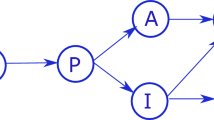Abstract
A large number of recent studies consider a compartmental SIR model to study optimal control policies aimed at containing the diffusion of COVID-19 while minimizing the economic costs of preventive measures. Such problems are non-convex and standard results need not to hold. We use a Dynamic Programming approach and prove some continuity properties of the value function of the associated optimization problem. We study the corresponding Hamilton–Jacobi–Bellman equation and show that the value function solves it in the viscosity sense. Finally, we discuss some optimality conditions. Our paper represents a first contribution towards a complete analysis of non-convex dynamic optimization problems, within a Dynamic Programming approach.
Article PDF
Similar content being viewed by others
Avoid common mistakes on your manuscript.
References
Acemoglu, D., Makhdoumi, A., Malekian, A., Ozdaglar, A.: Testing, voluntary social distancing and the spread of an infection. Technical report, National Bureau of Economic Research (2020)
Acemoglu, D., Chernozhukov, V., Werning, I., Whinston, M.D.: Optimal targeted lockdowns in a multigroup sir model. Am. Econ. Rev. Insights 3(4), 487–502 (2021)
Alvarez, F., Argente, D., Lippi, F.: A simple planning problem for COVID-19 lock-down, testing, and tracing. Am. Econ. Rev. Insights 3(3), 367–82 (2021)
Alvarez, F.E., Argente, D., Lippi, F.: A simple planning problem for COVID-19 lockdown. Technical report, National Bureau of Economic Research (2020)
Ash, T., Bento, A.M., Kaffine, D., Rao, A., Bento, A.I.: Disease-economy trade-offs under alternative epidemic control strategies. Nat. Commun. 13(1), 3319 (2022)
Aspri, A., Beretta, E., Gandolfi, A., Wasmer, E.: Mortality containment vs. economics opening: optimal policies in a SEIARD model. J. Math. Econ. 93, 102490, 19 (2021)
Atkeson, A.G.: What will be the economic impact of COVID-19 in the US? Rough estimates of disease scenarios. Staff Report 595, Federal Reserve bank of Minneapolis (2020)
Balderrama, R., Peressutti, J., Pinasco, J.P., Vazquez, F., de la Vega, C.S.: Optimal control for a SIR epidemic model with limited quarantine. Nat. Sci. Rep. 12, 12583:1 (2022)
Bambi, M., Gozzi, F.: Internal habits formation and optimality. J. Math. Econ. 91, 165–172 (2020). https://doi.org/10.1016/j.jmateco.2020.09.008
Bardi, M., Capuzzo-Dolcetta, I.: Optimal control and viscosity solutions of Hamilton–Jacobi–Bellman equations. In: Systems & Control: Foundations & Applications. Birkhäuser Boston, Inc., Boston, MA, (1997). With appendices by Maurizio Falcone and Pierpaolo Soravia
Bolzoni, L., Bonacini, E., Soresina, C., Groppi, M.: Time-optimal control strategies in SIR epidemic models. Math. Biosci. 292, 86–96 (2017)
Calvia, A.: Optimal control of continuous-time Markov chains with noise-free observation. SIAM J. Control Optim. 56(3), 2000–2035 (2018). https://doi.org/10.1137/17M1139989
Cannarsa, P., Sinestrari, C.: Semiconcave functions, Hamilton–Jacobi equations, and optimal control. In: Progress in Nonlinear Differential Equations and their Applications, vol. 58. Birkhäuser Boston, Inc., Boston, MA (2004)
Cannarsa, P., Soner, H.M.: Generalized one-sided estimates for solutions of Hamilton–Jacobi equations and applications. Nonlinear Anal. Theory Methods Appl. Int. Multidiscip. J. 13(3), 305–323 (1989). https://doi.org/10.1016/0362-546X(89)90056-4
Ciminelli, G., Garcia-Mandicó, S.: How healthcare congestion increases COVID-19 mortality: evidence from Lombardy, Italy. medRxiv (2020)
Crandall, M.G., Lions, P.-L.: Viscosity solutions of Hamilton–Jacobi equations. Trans. Am. Math. Soc. 277(1), 1–42 (1983)
Crandall, M.G., Ishii, H., Lions, P.-L.: User’s guide to viscosity solutions of second order partial differential equations. Am. Math. Soc. Bull. New Ser. 27(1), 1–67 (1992). https://doi.org/10.1090/S0273-0979-1992-00266-5
Eichenbaum, M.S., Rebelo, S., Trabandt, M.: The macroeconomics of epidemics. Rev. Financ. Stud. 34(11), 5149–5187 (2021)
Elhia, M., Rachik, M., Benlahmar, E.: Optimal control of an SIR model with delay in state and control variables. Int. Sch. Res. Not. 403549, 1–7 (2013)
Fabbri, G., Gozzi, F., Swiech, A.: Stochastic optimal control in infinite dimension. In: 82 of Probability Theory and Stochastic Modelling, vol. 82. Springer, Cham (2017). Dynamic programming and HJB equations, with a contribution by Marco Fuhrman and Gianmario Tessitore
Fabbri, G., Gozzi, F., Zanco, G.: Verification results for age-structured models of economic-epidemics dynamics. J. Math. Econ. 93, 102455 (2021)
Fabbri, G., Federico, S., Fiaschi, D., Gozzi, F.: Mobility decisions, economic dynamics and epidemic. Econ. Theory (2023). https://doi.org/10.1007/s00199-023-01485-1
Farboodi, M., Jarosch, G., Shimer, R.: Internal and external effects of social distancing in a pandemic. J. Econ. Theory 196, 105293 (2021)
Favero, C.: Why is COVID-19 mortality in Lombardy so high? Evidence from the simulation of a SEIHCR model. Covid Economics, Vetted and Real-Time Papers (2020)
Federico, S., Ferrari, G.: Taming the spread of an epidemic by lockdown policies. J. Math. Econ. 93, 102453 (2021). https://doi.org/10.1016/j.jmateco.2020.102453
Federico, S., Ferrari, G., Torrente, M.-L.: Optimal vaccination in a sirs epidemic model. Econ. Theory (2022). https://doi.org/10.1007/s00199-022-01475-9
Fleming, W.H., Rishel, R.W.: Deterministic and stochastic optimal control. In: Applications of Mathematics, no. 1. Springer-Verlag, Berlin, New York (1975)
Fleming, W.H., Soner, H.M.: Controlled Markov processes and viscosity solutions. In: Stochastic Modelling and Applied Probability, vol. 25, 4th edn. Springer, New York (2006)
Freni, G., Gozzi, F., Salvadori, N.: Existence of optimal strategies in linear multisector models. Econ. Theory 29(1), 25–48 (2006). https://doi.org/10.1007/s00199-005-0025-y
Freni, G., Gozzi, F., Pignotti, C.: Optimal strategies in linear multisector models: value function and optimality conditions. J. Math. Econ. 44(1), 55–86 (2008)
Goenka, A., Liu, L.: Infectious diseases, human capital and economic growth. Econ. Theory 70, 1–47 (2020)
Goenka, A., Liu, L., Nguyen, M.-H.: Infectious diseases and economic growth. J. Math. Econ. 50, 34–53 (2014). https://doi.org/10.1016/j.jmateco.2013.10.004
Goenka, A., Liu, L., Nguyen, M.-H.: SIR economic epidemiological models with disease induced mortality. J. Math. Econ. 93, 102476 (2021)
Goenka, A., Liu, L., Nguyen, M.-H.: Modelling optimal lockdowns with waning immunity. Econ. Theory 26, 58 (2022). https://doi.org/10.1007/s00199-022-01468-8
Gollier, C.: Cost-benefit analysis of age-specific deconfinement strategies. J. Public Econ. Theory 22(6), 1746–1771 (2020)
Jones, C., Philippon, T., Venkateswaran, V.: Optimal mitigation policies in a pandemic: social distancing and working from home. Rev. Financ. Stud. 34(11), 5188–5223 (2021)
Ketcheson, D.I.: Optimal control of an SIR epidemic through finite-time non-pharmaceutical intervention. J. Math. Biol. 83(1), 7 (2021)
Leitmann, G., Stalford, H.: A sufficiency theorem for optimal control. J. Optim. Theory Appl. 8, 169–174 (1971). https://doi.org/10.1007/BF00932465
Piguillem, F., Shi, L.: Optimal Covid-19 quarantine and testing policies. Econ. J. 132(647), 2534–2562 (2022)
Pollinger, S.: Optimal contact tracing and social distancing policies to suppress a new infectious disease. Econ. J. (2023). https://doi.org/10.1093/ej/uead024
Soner, H.M.: Optimal control with state-space constraint. I. SIAM J. Control Optim. 24(3), 552–561 (1986)
Soravia, P.: Optimality principles and representation formulas for viscosity solutions of Hamilton–Jacobi equations. I. Equations of unbounded and degenerate control problems without uniqueness. Adv. Differ. Equ. 4(2), 275–296 (1999)
Soravia, P.: Optimality principles and representation formulas for viscosity solutions of Hamilton-Jacobi equations. II. Equations of control problems with state constraints. Differential and integral equations. Int. J. Theory Appl. 12(2), 275–293 (1999)
Zaman, G., Kang, Y.H., Cho, G., Jung, I.H.: Optimal strategy of vaccination & treatment in an SIR epidemic model. Math. Comput. Simul. 136, 63–77 (2017). (ISSN 0378-4754)
Acknowledgements
The authors warmly thank the Referees and the Associate Editors for their careful scrutiny which brought to a substantially improved version of the paper.
Funding
Open access funding provided by Luiss University within the CRUI-CARE Agreement. F. Gozzi and F. Lippi acknowledge financial support from the ERC grant 101054421-DCS. Views and opinions expressed are however those of the author(s) only and do not necessarily reflect those of the European Union or the European Research Council. A. Calvia, F. Gozzi, G. Zanco are supported by the Italian Ministry of University and Research (MIUR), in the framework of PRIN project 2017FKHBA8 001 (The Time-Space Evolution of Economic Activities: Mathematical Models and Empirical Applications).
Author information
Authors and Affiliations
Corresponding author
Ethics declarations
Conflict of interest
The authors have no competing interests to declare that are relevant to the content of this article.
Additional information
Publisher's Note
Springer Nature remains neutral with regard to jurisdictional claims in published maps and institutional affiliations.
Rights and permissions
Open Access This article is licensed under a Creative Commons Attribution 4.0 International License, which permits use, sharing, adaptation, distribution and reproduction in any medium or format, as long as you give appropriate credit to the original author(s) and the source, provide a link to the Creative Commons licence, and indicate if changes were made. The images or other third party material in this article are included in the article’s Creative Commons licence, unless indicated otherwise in a credit line to the material. If material is not included in the article’s Creative Commons licence and your intended use is not permitted by statutory regulation or exceeds the permitted use, you will need to obtain permission directly from the copyright holder. To view a copy of this licence, visit http://creativecommons.org/licenses/by/4.0/.
About this article
Cite this article
Calvia, A., Gozzi, F., Lippi, F. et al. A simple planning problem for COVID-19 lockdown: a dynamic programming approach. Econ Theory 77, 169–196 (2024). https://doi.org/10.1007/s00199-023-01493-1
Received:
Accepted:
Published:
Issue Date:
DOI: https://doi.org/10.1007/s00199-023-01493-1
Keywords
- Controlled SIRD model
- Optimal lockdown policies
- Optimal control with state space constraints
- Optimality conditions
- Viscosity solutions




